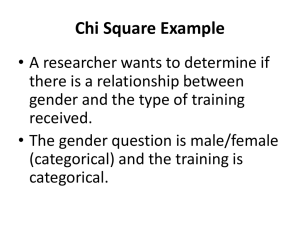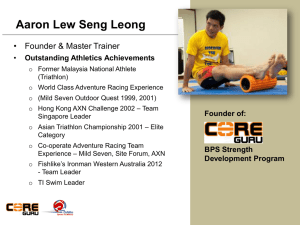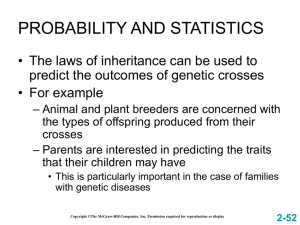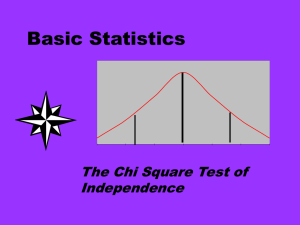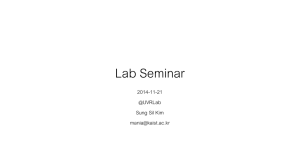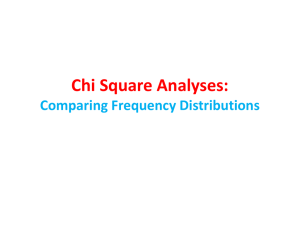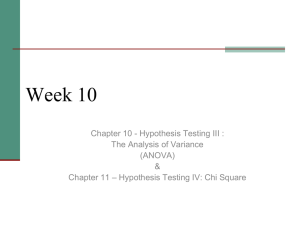4/23
advertisement
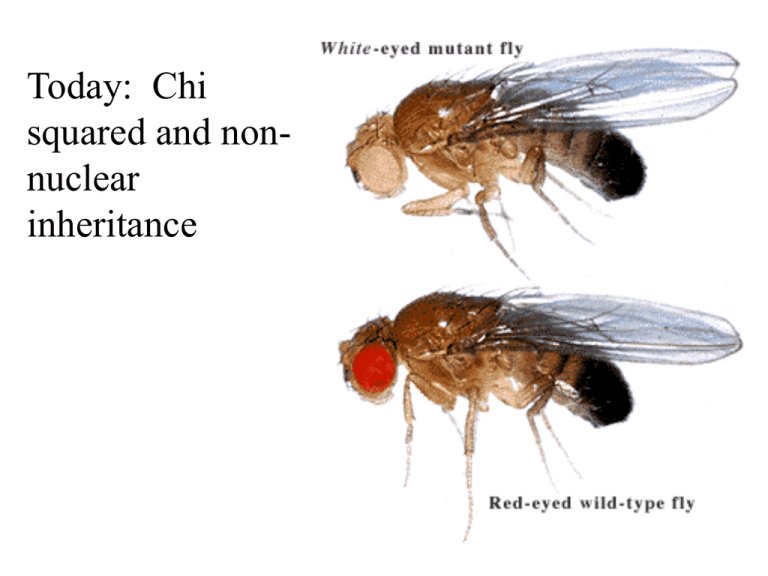
Today: Chi squared and nonnuclear inheritance Linkage can be used to determine distance Homologous pair of chromosomes =25% 42% 41% 9% 8% Are these differences from the expected result random or due to linkage? =25% 42% 41% 9% 8% The Chi Square Test • A statistical method used to determine goodness of fit – Goodness of fit refers to how close the observed data are to those predicted from a hypothesis • Note: – The chi square test does not prove that a hypothesis is correct • It evaluates whether or not the data and the hypothesis have a good fit • Consider the following example in Drosophila melanogaster Gene affecting wing shape + c = Normal wing c = Curved wing Note: The wild-type allele is designated with a + sign Recessive mutant alleles are designated with lowercase letters Gene affecting body color + e = Normal (gray) e = ebony The Cross: A cross is made between two true-breeding flies (c+c+e+e+ and ccee). The flies of the F1 generation are then allowed to mate with each other to produce an F2 generation. 2-69 Copyright ©The McGraw-Hill Companies, Inc. Permission required for reproduction or display The outcome F1 generation All offspring have straight wings and gray bodies F2 generation 193 straight wings, gray bodies 69 straight wings, ebony bodies 64 curved wings, gray bodies 26 curved wings, ebony bodies 352 total flies Applying the chi square test Step 1: Propose a hypothesis that allows us to calculate the expected values based on Mendel’s laws The two traits are independently assorting Copyright ©The McGraw-Hill Companies, Inc. Permission required for reproduction or display 2-70 Step 2: Calculate the expected values of the four phenotypes, based on the hypothesis According to our hypothesis, there should be a 9:3:3:1 ratio on the F2 generation Phenotype Expected probability Expected number straight wings, gray bodies 9/16 9/16 X 352 = 198 straight wings, ebony bodies 3/16 3/16 X 352 = 66 curved wings, gray bodies 3/16 3/16 X 352 = 66 curved wings, ebony bodies 1/16 1/16 X 352 = 22 Copyright ©The McGraw-Hill Companies, Inc. Permission required for reproduction or display 2-71 Copyright ©The McGraw-Hill Companies, Inc. Permission required for reproduction or display 2-72 Step 4: Interpret the chi square value The calculated chi square value can be used to obtain probabilities, or P values, from a chi square table These probabilities allow us to determine the likelihood that the observed deviations are due to random chance alone Low chi square values indicate a high probability that the observed deviations could be due to random chance alone High chi square values indicate a low probability that the observed deviations are due to random chance alone If the chi square value results in a probability that is less than 0.05 (ie: less than 5%) The hypothesis is rejected Copyright ©The McGraw-Hill Companies, Inc. Permission required for reproduction or display 2-73 Step 4: Interpret the chi square value Before we can use the chi square table, we have to determine the degrees of freedom (df) The df is a measure of the number of categories that are independent of each other df = n – 1 where n = total number of categories In our experiment, there are four phenotypes/categories Therefore, df = 4 – 1 = 3 Refer to Table 2.1 Copyright ©The McGraw-Hill Companies, Inc. Permission required for reproduction or display 2-74 1.06 2-75 Step 4: Interpret the chi square value With df = 3, the chi square value of 1.06 is slightly greater than 1.005 (which corresponds to P= 0.80) A P = 0.80 means that values equal to or greater than 1.005 are expected to occur 80% of the time based on random chance alone Therefore, it is quite probable that the deviations between the observed and expected values in this experiment can be explained by random sampling error Copyright ©The McGraw-Hill Companies, Inc. Permission required for reproduction or display 2-76 Chi Square Analysis • This method is frequently used to determine if the outcome of a dihybrid cross is consistent with linkage or independent assortment • An example of a chi square approach to determine linkage is shown next Copyright ©The McGraw-Hill Companies, Inc. Permission required for reproduction or display 5-20 Are these differences from the expected result random or due to linkage? =25% 42% 41% 9% 8% 2-75 Genotype Phenotype Genes code for proteins (or RNA). These gene products give rise to traits… It is rarely this simple. Sex-linked traits: Genes on the X chromosome A= normal ; a= colorblind No one affected, female carriers similar to Fig 4.13 50% of males affected, 0 % female affected 50% males affected, 50% females affected Is this all of your DNA? Fig 7.13 Mitochondria have their own DNA. Endosymbiotic Theory - proposed origin of mitochondria and chloroplasts from free-living bacteria to cellular organelles Fig 7.20 Human Life Cycle Combination of two individuals DNA Only the egg provides mitochondria to the offspring. mitochondria Human Life Cycle In females Mom provides 50.000275% and Dad provides 49.999825% of DNA to offspring. … because Mom provides 100% of mitochondrial DNA Mitochondrial DNA comparisons can be used to trace ancestry: During the Bolshevik revolution, the Tsar’s family was captured and executed. Tsar’s Family There are many stories about what happened to their youngest daughter Anastasia Tsar’s Family Anna Anderson, claimed she was Anastasia Anna Anderson claimed she was Anastasia, but tests of her mtDNA and one of Anastasia’s maternal relatives did not match. For more info check out: http://en.wikipedia.org/wiki/Grand_Duchess_Anastasia_Nikolaevna_of_Russia Or the book “Seven Daughters of Eve” by Bryan Sykes How do individuals and groups with different genes arise? Evolution… Does it occur? How does it occur?

